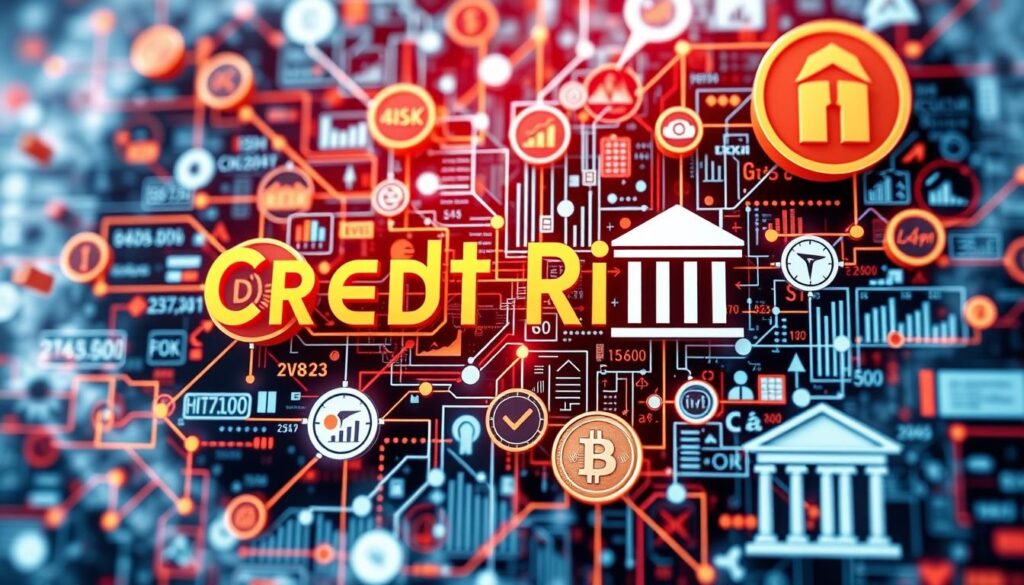AI and machine learning algorithms are reshaping credit risk modeling in financial services. These technologies promise better efficiency and precision in credit decisions. However, they risk perpetuating or worsening existing biases and discrimination.
This article explores AI bias in credit scoring, its causes, and regulatory concerns. We’ll look at strategies lenders can use to spot and reduce these biases. Understanding this challenge helps create fairer, more inclusive credit decisions.
Key Takeaways
- AI-driven credit scoring models can perpetuate and amplify existing biases, leading to unfair and discriminatory lending practices.
- Algorithmic biases can arise from a variety of sources, including biased training data and proxy discrimination.
- Lenders must navigate a complex regulatory landscape, including the Fair Credit Reporting Act (FCRA) and the Equal Credit Opportunity Act (ECOA), to ensure fair and responsible lending.
- Strategies for detecting and mitigating AI bias, such as bias testing, auditing, and algorithmic debiasing techniques, are crucial for achieving fair and ethical credit decisions.
- Responsible AI practices, including transparency, explainability, and human oversight, are essential for building trust and accountability in AI-powered credit scoring systems.
Understanding AI Bias in Credit Scoring
AI is now widely used in credit scoring models. It’s vital to grasp AI bias and its effects. AI bias can lead to unfair and discriminatory outcomes in credit decisions.
What is AI Bias?
AI bias comes in various forms. Data bias happens when training data doesn’t represent the whole population. This leads to skewed predictions.
Model bias stems from flaws in the AI algorithm itself. It can amplify existing biases or create new ones.
Proxy discrimination occurs when AI uses neutral variables as stand-ins for protected traits. This can result in unfair treatment of certain groups.
The Implications of Biased Credit Scores
AI bias in credit scoring can have serious consequences. It can lead to unfair lending decisions. Some people may be denied credit or given worse terms unfairly.
This can worsen existing social and economic gaps. It can cause disparate impact on protected groups, furthering inequality.
| Impact of AI Bias in Credit Scoring | Potential Outcomes |
|---|---|
| Unfair Lending Decisions | Denied credit or less favorable terms for individuals or communities based on factors unrelated to creditworthiness |
| Disparate Impact on Protected Groups | Perpetuation of systemic inequalities and exacerbation of social and economic disparities |
| Reinforcement of Biases | AI-powered credit scoring models can amplify and perpetuate existing societal biases |
Grasping ai bias in credit scores and algorithmic bias is key. It helps address challenges in AI-based credit risk modeling. Spotting and fixing these biases is crucial.
This ensures fair credit access. It promotes financial inclusion and a more just financial system.
Traditional Credit Scoring Models
Traditional credit scoring models have ruled for decades. They rely on factors like credit history, income, and employment status. These models have been crucial in the lending industry.
However, as finance evolves, their limits become clear. This is especially true for fair lending. Traditional models may not serve all borrowers equally.
One major issue is the potential for bias. Human-made models can reflect creator preconceptions. This may unfairly disadvantage certain groups. Such biases undermine credit risk modeling and fair lending practices.
| Strengths of Traditional Models | Limitations of Traditional Models |
|---|---|
|
|
The financial industry needs better credit scoring solutions. AI and machine learning models offer hope. They could address traditional model shortcomings. This may lead to fairer credit risk modeling.

The Rise of AI in Credit Risk Modeling
AI and machine learning are reshaping credit scoring. These technologies offer powerful tools for assessing creditworthiness. Lenders can now evaluate risk with greater efficiency and personalization.
Machine Learning Algorithms in Credit Scoring
Advanced algorithms analyze vast amounts of data. They spot complex patterns traditional models might miss. This helps lenders make more informed credit decisions.
AI’s predictive power improves risk management. It leads to better outcomes for both lenders and borrowers.
Potential Benefits of AI-Powered Credit Scoring
AI and machine learning in credit risk modeling offer several advantages:
- Enhanced Predictive Accuracy: AI models analyze more data points. This enables more precise predictions of creditworthiness and default risk.
- Increased Efficiency: Automated processes streamline credit applications and approvals. This reduces time and resource requirements.
- Personalized Assessments: AI algorithms tailor credit decisions to individual borrowers. They consider unique circumstances and financial profiles.
The rise of AI in credit scoring brings potential ai bias in credit scores. This must be addressed for fair lending. Ensuring machine learning fairness is vital as we advance credit risk modeling.
Common Sources of AI Bias in Credit Scores
AI-powered credit scoring models are becoming more common. It’s important to understand the sources of bias in these systems. Biased training data and proxy discrimination are two major contributors.
Biased Training Data
Historical lending patterns often reflect societal biases. These biases can be encoded into AI models. This perpetuates unfair lending decisions.
Lenders must carefully examine their training data. They need to identify and address any inherent biases. This step is crucial before deploying AI systems.
Proxy Discrimination
Proxy discrimination is another source of AI bias. It happens when neutral variables act as proxies for protected characteristics. These could include race, gender, or socioeconomic status.
For example, a model might use zip code as a factor. This could discriminate against applicants from low-income or minority areas. Identifying and addressing these proxy variables is vital.

Addressing AI bias is crucial for fair credit scoring. Lenders should examine their data and algorithms carefully. This helps create inclusive and unbiased credit models.
The goal is to make AI-powered credit decisions fair and transparent. This ensures they truly reflect an individual’s creditworthiness.
ai bias in credit scores
AI and machine learning in credit scoring bring benefits and challenges. Algorithmic bias can lead to unfair lending practices and disparate treatment. This issue affects individuals and communities alike.
Biased training data may not represent population diversity accurately. Proxy discrimination uses neutral variables correlated with protected characteristics. These factors contribute to algorithmic bias in credit scoring.
AI bias in credit scores can deny loans to creditworthy individuals. It may lead to higher interest rates for marginalized groups. This undermines fair lending principles and worsens socioeconomic disparities.
“AI-powered credit scoring models have the potential to either amplify or mitigate historical biases in lending. It’s critical that lenders proactively address algorithmic bias to ensure fair and equitable access to credit.”
Addressing AI bias in credit scores is crucial for an inclusive financial system. As AI-driven credit models grow, vigilance is key. Lenders, policymakers, and the public must identify and mitigate biases.
This effort upholds fair lending principles. It promotes financial opportunity for all. Continuous monitoring and improvement are essential for equitable credit scoring.
Regulatory Landscape and Fair Lending Laws
AI-powered credit scoring models are on the rise. It’s vital to grasp the rules that ensure fair lending. Two key laws protect consumers: the Fair Credit Reporting Act (FCRA) and the Equal Credit Opportunity Act (ECOA).
The Fair Credit Reporting Act (FCRA)
The Fair Credit Reporting Act oversees consumer credit info. It ensures credit agencies keep accurate reports. Consumers can access their reports and dispute errors.
The act also limits the sharing of personal information. This protects consumers’ privacy rights.
Equal Credit Opportunity Act (ECOA)
The Equal Credit Opportunity Act fights discrimination in lending. It bans bias based on race, color, religion, and other traits. Lenders must evaluate all applications fairly.
This law also covers AI-powered credit scoring models. It ensures these new tools don’t introduce unfair bias.
The FCRA and ECOA work together to promote fair lending. They prevent unfair practices in the credit industry. As AI shapes credit decisions, these laws ensure fairness and equality.

Detecting and Mitigating AI Bias
AI-powered credit scoring models are becoming more common. Lenders must actively detect and mitigate algorithmic bias. This bias can lead to unfair credit decisions that perpetuate historical inequalities.
Lenders can use various strategies to ensure fair and unbiased credit scoring systems. These methods help address the challenges of AI bias in lending.
Bias Testing and Auditing
Thorough bias testing and auditing are crucial for fair credit scoring models. This process analyzes inputs, outputs, and decision-making to detect unintended biases.
Lenders should conduct regular audits using specific techniques. These include disparate impact analysis and counterfactual testing. Such practices ensure models follow fair lending laws and responsible AI principles.
Algorithmic Debiasing Techniques
Lenders can use algorithmic debiasing techniques to reduce AI bias effects. These methods help create fairer credit scoring models.
- Data preprocessing: Clean training data to remove biases and ensure representative sampling.
- Model adjustments: Modify algorithms to reduce the influence of biased features.
- Post-processing: Apply debiasing methods to final outputs, like calibrating predictions or adjusting thresholds.
A comprehensive approach to algorithmic bias detection is essential. This helps lenders achieve machine learning fairness. It also enables responsible AI-powered credit decisions.
Ethical Considerations in AI-Powered Credit Scoring
Ethical AI in credit scoring raises concerns about transparency and fairness. Responsible AI integration into lending processes must address accountability issues. These systems could potentially perpetuate fair lending biases if not carefully implemented.
Transparency is crucial in AI-powered credit scoring models. Borrowers deserve to understand how their creditworthiness is assessed. Lenders must explain the logic behind their decisions to build trust.
Accountability is equally important in AI credit scoring. Clear responsibility lines and mechanisms must be established. Regular audits, bias testing, and algorithmic debiasing techniques can mitigate fair lending violation risks.
AI-driven credit scoring’s impact on vulnerable communities needs careful consideration. Algorithmic bias may perpetuate historical inequities. It could lead to credit access exclusion for certain groups.
Addressing this challenge requires a holistic approach. Incorporating diverse perspectives and community stakeholder input is essential. This ensures a more inclusive and fair credit scoring system.
“The use of ethical ai in credit scoring must be accompanied by a strong commitment to transparency, accountability, and the pursuit of fair and equitable lending practices.”
The financial industry must prioritize ethical considerations as it embraces responsible AI. Lenders should develop advanced credit scoring systems that are socially responsible. These systems must promote equity and fairness in lending practices.
Responsible AI Practices for Lenders
AI in credit scoring is growing. Lenders must use fair and ethical practices. Two key principles are transparency and human oversight.
Transparency and Explainability
Lenders should explain how AI models make decisions. This helps borrowers understand their credit scores. Transparency builds trust and addresses concerns about responsible ai and fair lending.
AI models should be easy to interpret. They should clearly show what factors affect credit scores.
Human Oversight and Accountability
AI credit scoring has benefits, but human oversight is crucial. Lenders need strong systems to monitor AI models. This helps identify and fix ethical ai issues.
Lenders must ensure fair, unbiased decisions. They are responsible for their AI credit scoring systems.
Using these practices, lenders can harness AI’s power responsibly. This upholds fairness, transparency, and accountability in credit scoring.
Industry Efforts and Collaborative Solutions
The financial industry is tackling AI bias in credit scoring. Lenders, tech providers, regulators, and advocates are working together. They aim to promote ethical and fair lending practices.
A key initiative is the Responsible AI in Financial Services framework. It guides the implementation of responsible AI principles. The framework focuses on transparency, accountability, and fairness in lending.
Participants share best practices to promote fair lending, responsible AI, and ethical AI. Their goal is to improve lending practices across the industry.
Regulatory bodies like the Consumer Financial Protection Bureau (CFPB) are taking action. They’re issuing policy guidelines and enforcing fair lending laws. These efforts aim to prevent discriminatory practices in lending.
Advocacy groups like the Center for Responsible Lending are driving change. They work with industry stakeholders to develop best practices. These organizations also conduct research and push for legislative reforms.

The financial sector is making progress against AI bias in credit scoring. Diverse stakeholders are working together to address this challenge. Their goal is to create a more transparent and inclusive lending landscape.
The Future of Fair and Ethical Credit Scoring
Credit scoring is evolving towards fairness and ethics. Lenders now prioritize unbiased and equitable credit models. This shift aims to create accurate and fair lending practices.
Machine learning algorithms are key to improving credit scoring. Lenders are refining these algorithms to reduce algorithmic bias. They focus on debiasing techniques and algorithmic audits for fair lending decisions.
Future credit scoring models will be more transparent. Borrowers will understand factors affecting their credit decisions better. Human oversight will ensure AI-powered systems uphold ethical lending principles.
Industry stakeholders are working together on fair lending solutions. They aim to address challenges in credit scoring with responsible AI. This collaboration involves regulators and consumer advocates.
The future promises a more inclusive financial system. Fair lending practices will become standard. Ethical AI will drive credit decisions, creating a more equitable landscape.
- Increased transparency and explainability in credit scoring models, allowing borrowers to better understand the factors that contribute to their credit decisions.
- Enhanced human oversight and accountability, ensuring that AI-powered credit scoring systems are regularly monitored and adjusted to uphold principles of fairness and ethical lending.
- Collaborative efforts among industry stakeholders, regulators, and consumer advocates to develop comprehensive solutions that address the challenges of fair lending and responsible AI in credit scoring.
“The future of credit scoring lies in the seamless integration of advanced technology and unwavering commitment to principles of fairness, transparency, and accountability.”
Conclusion
AI in credit scoring offers both opportunities and challenges. It can boost efficiency and financial inclusion. However, AI bias may amplify historical lending inequities.
Tackling AI bias in credit scores needs teamwork. Lenders, regulators, and the industry must collaborate. This involves thorough bias testing and auditing.
Implementing algorithmic debiasing techniques is crucial. Adopting responsible AI practices is also important. These should focus on transparency, accountability, and human oversight.
We can create a fairer financial system with technology. This requires prioritizing ethical considerations. We must focus on the needs of vulnerable individuals.
By doing so, we can unlock AI’s true potential in credit risk modeling. This path may be challenging, but it’s necessary for an equitable future.

